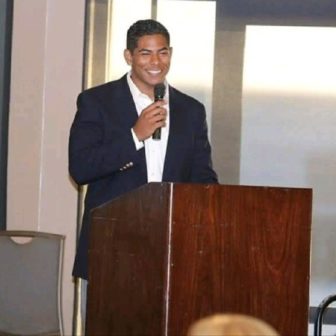Video by Yunuen Bonaparte
The shops are beginning to come alive on a Monday morning as Yamina Inzunza arrives at a coffee shop popular with college students in Riverside, Calif. Inzunza, 23, orders a smoothie filled with healthy ingredients and settles into a couch in the book-lined seating area to talk about the bumpy road that led her from foster care to community college and youth leader.
She is friendly and energetic, with a busy schedule consisting of college, a part-time job as a bartender, various leadership posts advocating for youth in foster care and artistic pursuits that include writing, music and dance.
“My life wasn’t butterflies,” said Inzunza, who first entered the foster system when she was 5. “It was hard. It was difficult. It took me so long to get here.”
She’s well aware that youth formerly in care face formidable obstacles in their educational path. Studies show that foster youth are the most likely to drop out of school and least likely to graduate high school, much less attend and graduate from college. In California, about 50 percent of foster students graduated from high school in the 2016-17 school year, compared to about 83 percent for all other students, according to the state Department of Education.
However, years of advocacy have resulted in better understanding of the needs of California’s foster students, translating into more funds that target gaps. School districts now report yearly on how funds earmarked for youth in care are spent, a relatively new requirement that advocates believe will further improve educational outcomes for these students. California, which has the largest group of foster youth in the country, often creates the mold for other states with its legislation and programs for foster youth.
“What started in California over 20 to 25 years ago is now starting to spread,” said Jim Mickelson, a child welfare social worker for more than 40 years and founder of ACE Scholars Services for foster youth at California State University, San Marcos.
A comprehensive list of Foster Youth Education Rights developed by the California Foster Youth Education Task Force details the state and federal laws protecting and aiding the estimated 55,000 foster students (2016-17 school year, the latest year of available statistics) enrolled K-12 in California public schools.
These laws are designed to address unique problems these youth encounter, such as frequent school changes and the need to designate an employee in each county to help college-bound foster students fill out college applications and financial aid forms.
Youth in system help shape laws
Notably, voices of current or former youth in care are usually included in the legislative process through their involvement in organizations such as California Youth Connection, where Inzunza received leadership training.

Xavier Mountain
“The only people who are going to speak up for us is us,” said Xavier Mountain, 26, who is pursuing his master’s degree in social work at the University of Southern California. Mountain, who was first placed in foster care when he was 2, has served in several leadership positions and is currently working as a youth advocate for John Burton Advocates for Youth. His drive for academic success is one he wants to promote among youth in care. He plans to apply to law school, partly because he wants to help his younger brother, who was involved with gangs and is currently in prison.
One in four foster youth become incarcerated within two years of aging out of care and up to 43 percent of of California prison inmates have spent time in foster care. Youth in foster care are at high risk of being unemployed or homeless within a few years of aging out of care.
These statistics show that, despite all the gains, challenges in meeting the educational needs of California youth in care remain. Educational funds aren’t always distributed as intended, a testament to the difficulties of a state widely spread over urban and rural areas. There are more than 1,000 school districts, more than 80 of them in Los Angeles County alone.
Programs aimed at helping high school students in care vary district by district. And while the state helps fund numerous support programs for current or former youth in care attending community colleges, such earmarked funding doesn’t exist for four-year public institutions.
Nevertheless, foster youth advocates point to limited success stories as evidence of progress.

CSUSM
Jim Mickelson
The “Gallery of Graduates” on a wall at ACE Scholars offices in San Marcos is the only proof Mickelson needs to know his program has been working. The wall displays 61 large framed photographs of graduates of the program since it launched in 2008. He anticipates having 74 on the wall by May 2019.
“I know, in the grand realm of numbers, that doesn’t seem like a lot,” Mickelson said. “But we worked with each one of those students for four to six years and we saw a transformation in each one of them.”
It’s the sort of transformation advocates know can multiply with the right resources and the right people to steer support programs for foster youth.
More foster students in California than ever are getting assistance in pursuing their college dreams, with more than 30,000 community college students and 4,400 students at state universities identifying as current or former foster youth, according to a new report by John Burton Advocates.
Nationally, only about 4 percent of such youth graduate from college by the time they’re 26, compared to 36 percent of the general population. This is the most cited statistic nationally, though studies showing the college graduation rate among foster youth can say it’s 1 to 11 percent. Such a wide variance exemplifies a major problem in identifying solutions. Differences in methodology, sample population, how each state calculates high school graduation rates, etc. make it difficult to compare programs from different states or even within a state.
This has highlighted the need for better data-gathering among the different government agencies involved in helping California youth in foster care, an effort now under way.
Support programs are a patchwork
Since 2015, $32 million in new state funding has been allocated to help foster youth pursue higher education, according to the report by John Burton Advocates. Those monies fund scholarships and support programs for current or former youth in care at community colleges. The San Francisco-based nonprofit manages California College Pathways, a collaboration between private and public entities designed to promote educational opportunities for foster youth.
At Riverside City College, foster youth specialist Jeremy Johnson has seen first-hand the effects of such partnerships. The college has a Guardian Scholars program that has grown from about 20 students in 2015 to about 150 this year. The program, one of many such programs at colleges and universities nationwide, is locally funded by the Anthony and Jeanne Pritzker Family Foundation and institutional funds. The program is designed to be a one-stop support center offering everything from mentorship to career counseling to amenities such as a computer lab and lounge with all the comforts of home, where students can relax on a couch, sip coffee or tea, and eat instant soups and other snacks.
“We want to make sure that students know, ‘Hey, college is something you can do and is realistic,’” Johnson said. “… We really help them along throughout their whole college career.”
Guardian Scholars are among a patchwork of support programs for foster students designed to replicate the role of a parent or guardian as closely as possible to guide students throughout high school and college. But when the parent role has been divided among so many different agencies, programs and people, every stage is fraught with the potential for that student to discontinue schooling.
In California, only 50.8 percent of youth in foster care graduated from high school in 2017, while 28.8 percent dropped out, according to the state Department of Education. The remaining students may still be pursuing a GED or other alternative schooling, or are taking longer to complete high school. This graduation rate is about the same as the national average, though the rate varies state by state. For example, in Washington the 2017 graduation rate among foster youth was 43 percent and in Texas it was 58 percent. Many advocates say foster students need more support and, most importantly, encouragement, earlier in their educational journey.
State funding sometimes spent elsewhere
To address concerns about inequities, the state Education Department began using a new funding formula that gives districts more local control over funding decisions and allocates extra funds for students classified as low income, English-learners and in care. The Local Control Funding Formula, first implemented in the 2013-14 school year, was to ensure that these students — the neediest, most at risk — would receive the support they need.

Yunuen Bonaparte
“All my life I’ve felt that people just saw me as money,” Yamina Inzunza said.
This hasn’t always been the case. Analyses by at least three different groups following the money trail in various school districts have shown some missteps.
For example, one audit found that Los Angeles Unified School District spent the bulk of its second-year funds of $145 million hiring back staff it had lost during recession cutbacks. These expenditures failed to address student inequities, according to the audit headed by researchers at University of California, Berkeley.
An audit by another group found that well-intentioned expenditures at some districts, such as bathroom remodels and new security, weren’t addressing the academic needs of the target population. Also, officials at one district decided to spend funds on students who they deemed would most benefit: the top 10 percent of students who they figured were most likely to go to college, said the report by The Local Control Funding Formula Research Collaborative, which has headquarters at the Stanford Graduate School of Education.
In Los Angeles County, a civil grand jury investigating 10 districts within the county found earlier this year that the “funding formula fails fosters.” The method of funding underrepresents the needs of foster students, who in Los Angeles County are often part of the other two most at-risk group of students, low-income and English-learners, the report said. Additionally, only five of the 10 districts surveyed had substantial programs specifically for youth in foster care.
The report was the third in recent years issued by Los Angeles County grand juries addressing the dire needs of the approximately 28,000 foster youth in the county. Last year’s report indicated the need for rapid improvement, noting that otherwise these youth are “doomed to a life of poverty and homelessness.”
Students in race against time, money
Indeed, the challenges for foster youth in Los Angeles County are magnified by the area’s high cost of living.

Rosemary Tong
At age 30, Rosemary Tong is still trying to complete community college while working about 60 hours a week. She has enrolled in community college or vocational school numerous times since she graduated from high school at 18. She was dependent on public transportation until three years ago. Living in one of the most expensive cities in the country has forced her to drop out midway through semesters so she could supplement her income by cleaning houses in order to pay rent or buy food.
Tong has used food and book vouchers offered by the Guardian Scholars program at Santa Monica College, but feels the program needs more counselors for more individualized assistance. Legislation signed by Gov. Jerry Brown recently extends the eligibility age of certain state scholarships to former foster youth from 22 to 26 but she has aged out of that form of assistance.
“I’ve just been kind of taking it one step at a time, taking one class at a time,” Tong said. “My ultimate dream goal is, I don’t know if it’s going to happen, like even school I couldn’t imagine, but I want to have my own business.”
Tong, who is aiming for a business entrepreneurship degree, envisions one day running a “healing center” that offers classes and resources for foster youth and others suffering from trauma. Her story illustrates the difficulties faced by foster youth whose determination to succeed in college is stymied by having to tend to basic needs such as housing and food.
If anything, California’s new school funding formula has put the needs of youth in care in the spotlight. Further, school districts are now required to file detailed written reports about how it spends the funds and how it serves disadvantaged students. The reports are available online.
In advocating for foster youth, Inzunza stresses the need for educators to find ways to offer one-on-one mentoring, which is actually the direction increasingly taken by most successful support programs for foster youth. Inzunza believes that individualized approach is key to connecting with foster youth.
“I can live on $5 for two weeks, eating rice, beans and carrots. I’ve done it many times. Money means nothing to me. All my life I’ve felt that people just saw me as money,” Inzunza said, her eyes tearing up. “In the foster care system, everyone treats you as though we’re all the same, but we’re not. We’re people and each one of us is an individual.”
This yearlong reporting project is made possible in part by The New York Foundling, which works with underserved children, families and adults with developmental disabilities. Throughout this project, Youth Today will maintain editorial independence.





























